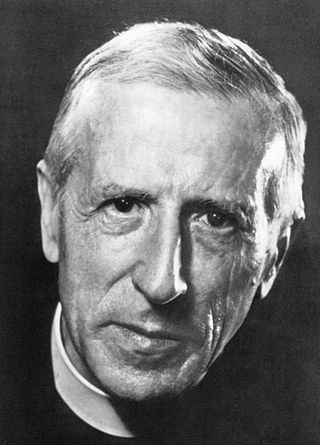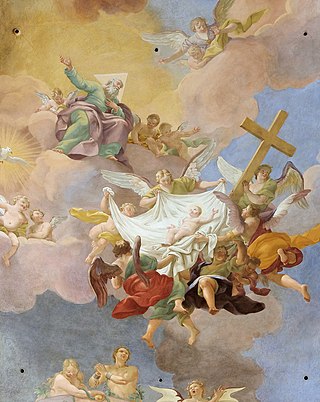Related Research Articles

In Christianity, Christology, translated from Greek as 'the study of Christ', is a branch of theology that concerns Jesus. Different denominations have different opinions on questions such as whether Jesus was human, divine, or both, and as a messiah what his role would be in the freeing of the Jewish people from foreign rulers or in the prophesied Kingdom of God, and in the salvation from what would otherwise be the consequences of sin.

The Epistle to the Colossians is the twelfth book of the New Testament. It was written, according to the text, by Paul the Apostle and Timothy, and addressed to the church in Colossae, a small Phrygian city near Laodicea and approximately 100 miles (160 km) from Ephesus in Asia Minor.

Pierre Teilhard de Chardin was a French Jesuit, Catholic priest, scientist, paleontologist, theologian, philosopher, and teacher. He was Darwinian in outlook and the author of several influential theological and philosophical books. His mainstream scientific achievements included taking part in the discovery of Peking Man. His more speculative ideas, sometimes criticized as pseudoscientific, have included a vitalist conception of the Omega Point and the development along with Vladimir Vernadsky of the concept of a noosphere.
The Omega Point is a theorized future event in which the entirety of the universe spirals toward a final point of unification. The term was invented by the French Jesuit Catholic priest Pierre Teilhard de Chardin (1881–1955). Teilhard argued that the Omega Point resembles the Christian Logos, namely Christ, who draws all things into himself, who in the words of the Nicene Creed, is "God from God", "Light from Light", "True God from True God", and "through him all things were made". In the Book of Revelation, Christ describes himself three times as "the Alpha and the Omega, the beginning and the end". Several decades after Teilhard's death, the idea of the Omega Point was expanded upon in the writings of John David Garcia (1971), Paolo Soleri (1981), Frank Tipler (1994), and David Deutsch (1997).

In Christianity, Jesus is believed to be the Son of God as chronicled in the Bible's New Testament, and in most Christian denominations he is held to be God the Son, a prosopon (person) of the Trinity of God.

Jürgen Moltmann is a German Reformed theologian who is Professor Emeritus of Systematic Theology at the University of Tübingen and is known for his books such as the Theology of Hope, The Crucified God, God in Creation and other contributions to systematic theology.
Pleroma generally refers to the totality of divine powers. It is used in Christian theological contexts, as well as in Gnosticism. The term also appears in the Epistle to the Colossians, which is traditionally attributed to Paul the Apostle. The word is used 17 times in the New Testament.
K. H. Ting, Ting Kuang-hsun or Ding Guangxun, was Chairperson emeritus of the Three-Self Patriotic Movement (TSPM) and President emeritus of the China Christian Council, the government-approved Protestant church in China.

The Pauline epistles are the thirteen books in the New Testament traditionally attributed to Paul the Apostle.
Hypostatic union is a technical term in Christian theology employed in mainstream Christology to describe the union of Christ's humanity and divinity in one hypostasis, or individual personhood.

Thomas Mulvihill King, S.J. was a professor of theology at Georgetown University. King entered the Society of Jesus in 1951 after completing undergraduate studies in English at the University of Pittsburgh. As a Jesuit, he undertook further studies at Fordham University and Woodstock College and was ordained a Roman Catholic priest in 1964. After completing a doctorate in theology at the University of Strasbourg in 1968, King began teaching at Georgetown. A member of the American Teilhard Association, he has written or edited several books on Pierre Teilhard de Chardin, including Teilhard's Mysticism of Knowing (1981), Teilhard and the Unity of Knowledge (1983) Teilhard de Chardin (1988), The Letters of Teilhard de Chardin and Lucile Swan (1993) and Teilhard's Mass (2005). His other works include Sartre and the Sacred (1974), Enchantments: Religion and the Power of the Word (1989), Merton: Mystic at the Center of America (1992) and Jung's Four and Some Philosophers (1999). He also wrote the introduction for a new 2004 translation by Sion Cowell of Teilhard's The Divine Milieu.
The "image of God" is a concept and theological doctrine in Judaism and Christianity. It is a foundational aspect of Judeo-Christian belief with regard to the fundamental understanding of human nature. It stems from the primary text in Genesis 1:27, which reads: "So God created man in his own image, in the image of God created he him; male and female he created them." The exact meaning of the phrase has been debated for millennia.

Richard John Bauckham is an English Anglican scholar in theology, historical theology and New Testament studies, specialising in New Testament Christology and the Gospel of John. He is a senior scholar at Ridley Hall, Cambridge.
Ecotheology is a form of constructive theology that focuses on the interrelationships of religion and nature, particularly in the light of environmental concerns. Ecotheology generally starts from the premise that a relationship exists between human religious/spiritual worldviews and the degradation or restoration and preservation of nature. It explores the interaction between ecological values, such as sustainability, and the human domination of nature. The movement has produced numerous religious-environmental projects around the world.
Kazoh Kitamori was a Japanese theologian, pastor, author, professor, and churchman. His most famous work in the West is The Theology of the Pain of God, which was published in 1946 in Japan and in the United States in 1965. He was a longtime professor at Tokyo Union Theological Seminary. He was, along with Kōsuke Koyama, a leading contributor to Protestant Christian theology from twentieth century Japan.

Charles Earle Raven was an English theologian and Anglican priest. He was Regius Professor of Divinity at Cambridge University (1932–1950) and Master of Christ's College, Cambridge (1939–1950). His works have been influential in the history of science publishing on the positive effects that theology has had upon modern science.

The pre-existence of Christ asserts the existence of Christ prior to his incarnation as Jesus. One of the relevant Bible passages is John 1:1–18 where, in the Trinitarian interpretation, Christ is identified with a pre-existent divine hypostasis called the Logos. There are nontrinitarian views that question the aspect of personal pre-existence, the aspect of divinity, or both.

The Last Adam, also given as the Final Adam or the UltimateAdam, is a title given to Jesus in the New Testament. Similar titles that also refer to Jesus include Second Adam and New Adam.
Wang Weifan was an evangelical Christian leader of the state-sanctioned Protestant church of mainland China, the Three-Self Patriotic Movement. He was well-loved as a preacher, theologian, and devotional writer.
Jia Yuming was a Chinese Christian theologian and biblical commentator. He worked at several seminaries and eventually became a vice-chairperson of the Communist Party-aligned Three-Self Patriotic Movement. He self-identified as a fundamentalist and taught that "perfect salvation", which in his definition entailed becoming a "Christ-human", was the ultimate goal of all Christians.
References
- ↑ Kooten, Geurt Hendrik van (2003). Cosmic Christology in Paul and the Pauline School: Colossians and Ephesians in the Context of Graeco-Roman Cosmology, with a New Synopsis of the Greek Texts. Tübingen: Mohr Siebeck. ISBN 9783161480072.
- ↑ Galloway, Allan Douglas (1951). The Cosmic Christ. London: Harper. pp. 121–130.
- ↑ Lyons, James A. (1982). The cosmic Christ in Origen and Teilhard de Chardin: a comparative study. Oxford: Oxford University Press. pp. 202–203. ISBN 9780198267218.
- ↑ Pihkala, Panu (2017). Early Ecotheology and Joseph Sittler. LIT Verlag Münster. ISBN 9783643908377.
- ↑ Fox, Matthew (1988). The Coming of the Cosmic Christ. Harper Collins. ISBN 9780060629151.
- ↑ Rohr, Richard (2021). The universal Christ : how a forgotten reality can change everything we see, hope for, and believe. New York. ISBN 978-0-593-23832-5. OCLC 1155071369.
{{cite book}}: CS1 maint: location missing publisher (link) - ↑ Moltmann, Jürgen (1993). The Way of Jesus Christ: Christology in Messianic Dimensions. Fortress Press. pp. 274–280. ISBN 9781451412079.
- ↑ Levison, John R.; Pope-Levison, Priscilla (January 1994). "Toward an Ecumenical Christology for Asia". Missiology: An International Review. 22 (1): 3–17. doi:10.1177/009182969402200101. ISSN 0091-8296. S2CID 144194286.
- 1 2 Tang, Edmond (October 1995). "The Cosmic Christ — the search for a Chinese theology". Studies in World Christianity. 1 (2): 131–142. doi:10.3366/swc.1995.1.2.131. ISSN 1354-9901.
- ↑ Chow, Alexander (2013). Theosis, Sino-Christian Theology and the Second Chinese Enlightenment: Heaven and Humanity in Unity. New York: Palgrave Macmillan. pp. 89–111. doi:10.1057/9781137312624. ISBN 9781137312624.
- ↑ Chow, Alexander (July 2016). "Wang Weifan's Cosmic Christ: Wang Weifan's Cosmic Christ" (PDF). Modern Theology. 32 (3): 384–396. doi:10.1111/moth.12260. hdl: 20.500.11820/354a4459-7dbe-41a1-bc83-4bd08245fcb9 .